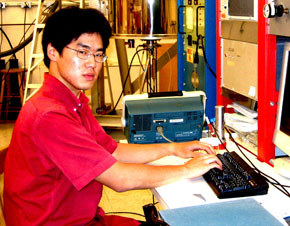
Jongjin Kim
Massachusetts Institute of Technology
Griffin Laboratory
Mentor: Jozef Lewandowski
Summer 2007
Solid-State NMR Study of Fibril-Forming Peptide GNNQQNY
Amyloid fibrils are formed by the misfolding of proteins into long fibers. It is known that the proteins make cross-beta interactions, but the details of fibril formation are still not fully understood. One protein that can form fibrils is Sup35p; surprisingly, the short sequence GNNQQNY from the N-terminal domain can also form fibrils, suggesting that fibril formation of the whole protein is caused by this segment. GNNQQNY can also form orthorhombic and monoclinic crystals, which can be studied as simplified models of the fibrils. The Griffin group has observed GNNQQNY in the crystal and fibril forms by solid- state NMR, and an interesting result came in the tyrosine signals. By 13C NMR, the monoclinic crystals have a normal signal from the aromatic carbons on the tyrosine; with orthorhombic crystals, however, those signals are attenuated. Presumably, the aromatic rings are rigid in the monoclinic system but are rotating in the orthorhombic, broadening the signal by carbon-carbon exchange. The goal of my research was to produce orthorhombic GNNQQNY and study the dynamics of the tyrosine ring flip. Unfortunately, the orthorhombic crystals were difficult to obtain, but study of a monoclinic sample gave useful results. The polypeptide in a monoclinic crystal is presumed to be rigid, judging by X-ray crystallography and previous NMR studies. However, a few peaks of the 13C spectrum shift when the sample is cooled to around -50°C, which may indicate a low-temperature conformation change. More data has not yet been obtained on this effect. Lastly, as of this writing, we have finally obtained a sample of orthorhombic crystals, and we are probing it by varying 1H-13C cross polarization contact times and by varying the temperature.